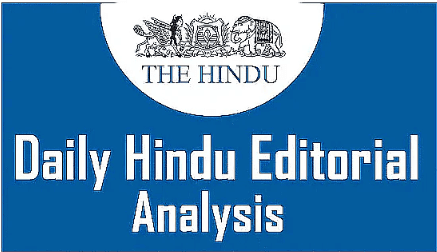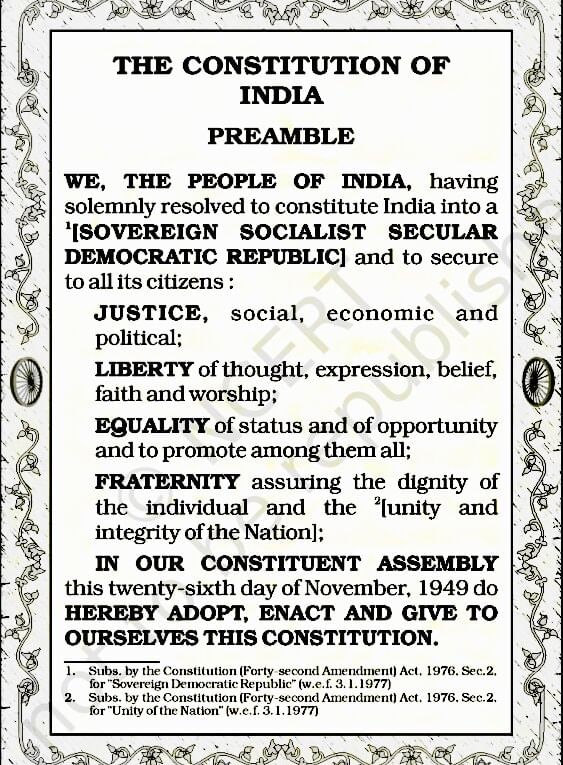The Hindu Editorial Analysis- 27th November 2024 | Current Affairs & Hindu Analysis: Daily, Weekly & Monthly - UPSC PDF Download

Timely Reiteration
Why in News?
The Supreme Court of India has done well to rebuff an attempt to question the characterisation of the country as ‘secular’ and ‘socialist’ in the amended Preamble to the Constitution. Sections of the right wing have been uneasy for long about the identification of secularism as one of the attributes of India. This opposition has acquired traction among those who see the combination of the state not favouring or opposing any religion and the constitutional protection for minorities as something that renders the polity “pseudo-secular”.

Meaning of the Preamble to the Indian Constitution
- The term Preamble refers to the introduction or opening section of the Constitution.
- It provides a brief overview or essence of the Constitution, highlighting the key ideals and goals that the Indian state is based on.
- The renowned legal expert N.A. Palkhivala described it as the “Identity Card of the Constitution”, emphasizing its importance in defining the Constitution’s purpose.
- Likewise, K.M. Munshi referred to it as the “Political Horoscope of the Constitution”, suggesting it outlines the fundamental principles and aspirations of the nation.
Historical Background
- On December 13, 1946, Nehru presented the ‘Objective Resolution’ in the Constituent Assembly.
- This resolution outlined the main goal or purpose of the Indian Constitution.
- It served as a guiding principle for the members of the assembly while they were creating the constitution.
- The same resolution was later accepted as the Preamble to the Indian Constitution on January 22, 1947.
Text of the Preamble
We, THE PEOPLE OF INDIA, having solemnly resolved to constitute India into a SOVEREIGN SOCIALIST SECULAR DEMOCRATIC REPUBLIC and to secure to all its citizens:
JUSTICE, Social, Economic and Political;
LIBERTY of thought, expression, belief, faith and worship;
EQUALITY of status and of opportunity and to promote among them all;
FRATERNITY assuring the dignity of the individual and the unity and integrity of the Nation;
In Our Constituent Assembly, this 26th day of November 1949, do HEREBY ADOPT, ENACT, and GIVE TO OURSELVES THIS CONSTITUTION.
Features of Preamble of Indian Constitution
- The Preamble of the Indian Constitution is a brief yet complete introduction that describes the main ideas and goals of the Constitution.
- It emphasizes India's dedication to being a Sovereign, Socialist, Secular, and Democratic Republic, which guarantees freedom, equality, and a government that respects all religions.
- The Preamble assures justice in social, economic, and political aspects, along with liberty in thought, expression, belief, faith, and worship.
- It promotes equality in status and opportunities for all individuals.
- The Preamble also encourages fraternity to foster unity among the people and uphold the dignity of each person.
- It mirrors the dreams and hopes of the citizens of India and acts as the essence and guiding principle of the Constitution.
- As a vital section of the Constitution, it embodies its spirit and purpose.
Components of the Preamble
- Source of authority for the Constitution – The Preamble indicates that the Constitution gets its power from the people of India.
- Nature of Indian State – It defines India as a Sovereign, Socialist, Secular, Democratic, and Republican nation.
- Objectives of the Constitution – It outlines Justice, Liberty, Equality, and Fraternity as the main goals.
- Date of adoption of the Constitution – It sets November 26, 1949, as the day the Constitution was officially adopted.
Key Words in The Preamble
“We, the People of India”
- This phrase shows that the Constitution of India gets its power from the people.
- It means that the Constitution is created and accepted by the people, not forced by anyone else.
- This reflects the desires and goals of the citizens.
- It highlights the citizens' power and duty to govern themselves and be part of democracy.
Sovereign
- The term ‘sovereign’ means India is not controlled by any other country.
- India manages its own internal and external matters independently.
- As a sovereign nation, India can acquire or give up territory.
Socialist
- The word ‘socialist’ refers to a system that aims for fair sharing of wealth and resources.
- It seeks to reduce economic differences among people.
- India practices ‘democratic socialism,’ where both private and public sectors exist together.
Secular
- The term ‘secular’ means that the state treats all religions equally and stays neutral.
- All religions in India are given the same respect and support by the government.
- This principle promotes harmony and respect for different beliefs in a diverse society.
Democratic
- The word ‘democratic’ means that the government is accountable to the people.
- It operates based on the consent of the citizens.
- India has a representative parliamentary democracy where the executive answers to the legislature.
- Key features include universal voting for adults, regular elections, and rule of law.
- This concept includes political, social, and economic democracy.
Republic
- The term ‘republic’ means the head of state is elected, not chosen by birth or family.
- This shows a move away from monarchy, establishing a government based on democratic values.
- It means that power lies with the people, and all citizens can hold public office without discrimination.
Justice
- The term ‘justice’ signifies the commitment to ensure fairness for all citizens.
- Social justice means treating everyone equally, regardless of their background.
- Economic justice involves not discriminating based on wealth and aiming to reduce income differences.
- Political justice ensures equal rights and access to political positions for all citizens.
- The ideals of justice were influenced by the Russian Revolution.
Liberty
- The term ‘liberty’ refers to freedom from restrictions, allowing personal growth.
- The Preamble aims to secure fundamental rights, including freedom of thought and expression.
- This liberty is not absolute; it comes with certain limits set by the Constitution.
Equality
- The term ‘equality’ means no special privileges for any group and equal chances for everyone.
- The Preamble guarantees equality in three ways:
- Civic Equality: Ensured by Fundamental Rights (Articles 14-18).
- Political Equality: Guaranteed through electoral provisions (Articles 325 and 326).
- Economic Equality: Promoted by Directive Principles (Article 39), ensuring equal rights and pay for all.
Fraternity
- The term ‘fraternity’ highlights the need for brotherhood and unity among citizens.
- The Preamble emphasizes two main aspects: the dignity of each individual and national unity.
- Dignity of the individual: The Constitution aims to improve the quality of life for everyone.
- Unity and integrity of the nation: Focused on overcoming divisions like communalism and regionalism.
Significance of Preamble of Indian Constitution
- The Preamble of the Indian Constitution reflects the core ideas and important values that the Constitution is built upon. It offers a brief overview of the Constitution of India.
- As the heart of the Constitution, it acts as a guiding framework for understanding and applying the various rules within the Constitution.
- It serves as a beacon for governance, providing moral direction to policymakers and lawmakers. It reminds them of the important goals of justice, equality, liberty, and fraternity that they should aim for in their decisions.
- The Preamble represents the unity and diversity of India by recognizing the varied backgrounds, languages, cultures, and religions of its people.
- It inspires citizens by reminding them of their rights, duties, and responsibilities towards the nation. It fosters a sense of patriotism, civic duty, and dedication to the principles of justice, equality, and fraternity among the people.
Major Issues and Judgments Related to the Preamble
Is the Preamble a Part of the Constitution of India?
One major topic of discussion regarding the Preamble of India is whether it is considered a part of the Constitution. The change in views on this issue can be seen through important Supreme Court cases:
Berubari Union Case, 1960
- The Supreme Court stated that the Preamble is not a part of the Constitution.
- The Preamble helps in understanding the thoughts of the Constitution's creators, and it can be used to clarify any unclear parts of the Constitution.
After this case, the Preamble was seen as not part of the Constitution, but it could still assist in interpreting the Constitution.
Kesavananda Bharati Case, 1973
- The Supreme Court changed its view and declared that the Preamble is now considered a part of the Constitution.
- It plays an important role in interpreting laws and other parts of the Constitution.
LIC of India Case, 1995
- The Supreme Court again confirmed that the Preamble is an essential part of the Constitution.
- However, it cannot be enforced directly in a court of law in India.
Can the Preamble be Amended?
Another significant question is whether the Preamble can be changed under Article 368. The development of opinions on this matter can be seen in important cases:
Kesavananda Bharati Case, 1973
- The Supreme Court ruled that since the Preamble is part of the Constitution, it can be amended, but no changes can be made to the 'Basic Structure' of the Constitution.
Amendment to the Preamble
- The Preamble has been changed only once through the 42nd Constitutional Amendment Act of 1976.
- This change was made based on the recommendations from the Sardar Swaran Singh Committee.
- Three words were added: Socialist, Secular, and Integrity.
- The words Socialist and Secular were added between Sovereign and Democratic.
- Additionally, Unity of the Nation was changed to Unity and Integrity of the Nation.
The Preamble of the Indian Constitution acts as a foundational document that outlines the goals of the entire Constitution. It serves as a guiding principle for lawmakers, who must consider the Preamble when creating laws.
|
63 videos|5408 docs|1146 tests
|
FAQs on The Hindu Editorial Analysis- 27th November 2024 - Current Affairs & Hindu Analysis: Daily, Weekly & Monthly - UPSC
| 1. What is the main theme of the editorial "Timely Reiteration"? |  |
| 2. How does the editorial suggest improving public awareness on key issues? |  |
| 3. What role does repetition play in the context of the editorial? |  |
| 4. Can you explain the significance of timely communication as mentioned in the editorial? |  |
| 5. What are some examples of issues that require timely reiteration according to the editorial? |  |





















